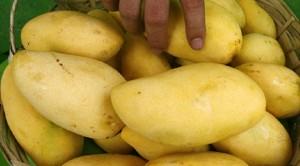US opens door to more fresh mangoes from PH

The US Department of Agriculture has ruled that mangoes from nearly anywhere in the Philippines can now be exported to the US. INQUIRER FILE PHOTO
WASHINGTON, DC — More fresh, sweet mangoes from the Philippines will be coming to the United States as a result of Washington’s recent decision to allow importation of mangoes from nearly any area in the archipelago.
The US Department of Agriculture (USDA) recently declared that the whole Philippines, with the exception of the island-province of Palawan, is now free from pests, particularly pulp and seed weevil. The ruling resulted from an extensive survey conducted in 79 provinces in Luzon, Visayas and Mindanao.
This means there is now greater opportunity for mango exports, the Philippine Embassy said in a statement. Agriculture Attache Josyline Javelosa said this market opening presents an opening for mango-producing provinces like Ilocos Norte, Pangasinan, Isabela, Batangas and Tarlac in Luzon; Cebu and Iloilo in the Visayas; and Zamboanga del Norte, North Cotabato and Davao del Sur in Mindanao, to name a few.
Palawan mangoes still OK
Javelosa said that Palawan, which was declared by USDA to be free from seed weevil, could still export its mango produce to the US mainland, but only after having the produce go through irradiation treatment.
Before this ruling, only mangoes grown in Guimaras, an island in the Visayas that has been recognized as weevil-free, could be exported to the US mainland. Mangoes grown from other parts of the Philippines suspected to have weevils, except Palawan, could be exported only to Guam and Hawaii.
Ambassador Jose L. Cuisia, Jr. welcomed the USDA announcement: “The decision to expand the list of allowable mango-producing areas to export to the US to almost the entire Philippines can be expected to result in more investments in the sector and at the same time encourage new entrants to allow domestic production to fully satisfy demand.”
Could expand exports
He said the USDA ruling should also attract other countries in looking into the Philippines as a source of mango supply following the USDA declaration that the country is largely weevil-free.
“Other countries could also refer to this USDA recognition of the Philippines as weevil-free as a basis for adjusting their phytosanitary and importation requirements for our mangoes,” Cuisia added.
Cuisia noted that the Philippine mango is knownworldwide for its superior taste, which should allow it to command a premium price.
Javelosa said that as a result of the USDA ruling, mangoes can now be allowed for export to anywhere in the US and its territories after undergoing vapor-heat treatment or irradiation at 150gy, pre-clearance procedures and other phytosanitary requirements effective 1 October 2014.
Javelosa pointed out that the USDA ruling also establishes a lower irradiation dose as a treatment for mango pulp weevil at 165gy from the generic dose of 300gy. She said that mango growers in Palawan will benefit from this ruling as it offers them a less costly treatment compared to irradiation at the higher dose.
According to the Bureau of Plant Industry, the major regular and lucrative markets for Philippine mangoes are Japan and South Korea, which accounted for 29 percent or 5,363 metric tons of the total Philippine mango export volume of 18,440 metric tons in 2012.
The rest of the country’s fresh mango produce was exported to Hong Kong, China, Singapore, New Zealand, the Middle East and Canada, among other markets.
In a recent Food and Agriculture Organization (FAO) case study of the Philippine mango industry authored by Briones, Turingan and Rakotoarisoa, several ongoing initiatives were identified to help new investors in mango exporting and processing.
These include the nationwide farmers’ registry being developed by the Department of Agriculture to help locate suppliers with track record of producing good-quality mangoes; research and development efforts to further improve mango production and postharvest technologies; and extension measures to promote improved technologies for increased yield and quality such as in fertilizer management, integrated pest management and flower induction.
RELATED STORIES
USDA eyes more mango shipments from PH
Mango farming for profit and environmental preservation














